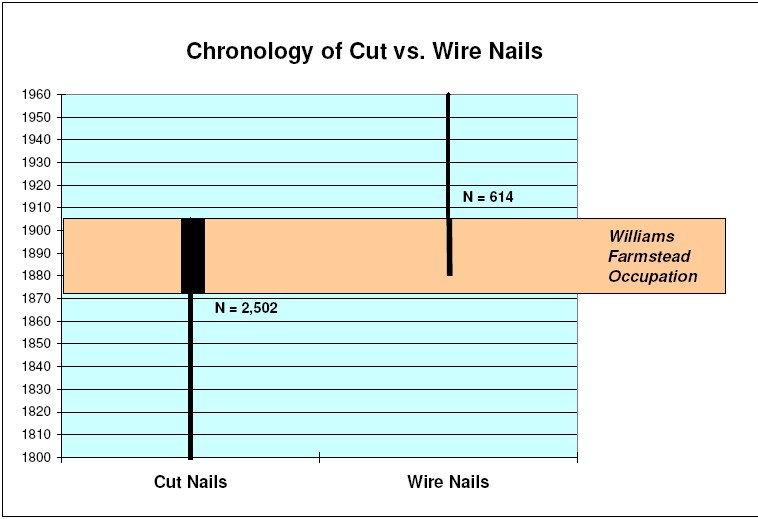
Cut nails (often called square nails or square-cut nails) and wire nails are two of the most common items recovered from the Williams farmstead that have temporal significance. This graph at right illustrates the chronology and frequency of all cut and wire nails recovered from the farmstead excavations.
The 1871–1905 occupation period for the Williams farmstead overlaps the periods of common usage and transition from cut to wire nails. Cut nails were produced throughout the nineteenth century, but the automated mass-manufacture of wire nails began in America about 1880. Because this process was so efficient, wire nails could be produced faster and were much less expensive. By 1892, half of all nails manufactured in the United States were wire. By 1900, cut nail production was in serious decline, and nearly all manufacturers had switched to making only wire nails.
The fact that cut nails are four times more common than wire nails in the farmstead assemblage is interpreted as evidence that the improvements on Ransom Williams farm were built prior to 1880 and the wire nails were probably incorporated in subsequent repairs or additions. The house excavation block yielded 1540 cut nails to 388 wire nails, again for a ratio of almost 4 to 1. This evidence also suggests that the house construction was before 1880 and that the wire nails represent later repair episodes. Looking only at the 90 units comprising the house excavation block, the overall number of nails is 1,928, and the density of cut is 17.1 per square meter while the density of wire nails is 4.3 per square meter. Thus, the nail frequencies and densities are far too low to account for a wooden frame house, but the data are consistent with evidence observed for log cabins at several other late-nineteenth-century Texas sites. The conclusion is that the nail frequency and density data and the cut to wire nail ratios for the house excavation block provide circumstantial evidence for the Williams house having been a log cabin.